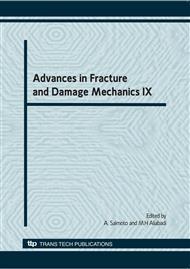p.325
p.329
p.333
p.337
p.341
p.345
p.349
p.353
p.357
Image Based Displacement Vector Estimation Method around the Fatigue Crack Tip
Abstract:
To clarify the instantaneous strain field during the fatigue crack propagation test, an attempt is made to estimate the displacement vector of the small area of the crack tip from the high speed movie. The key theory of the estimation is Particle Image Velocimetry (PIV) which is frequently use in the fluid dynamical data analysis. PIV means the area based correlation matching between the sequential image pair. At first the earlier image divided into the small subareas, and on the later image most correspondent position to the subarea is searched. The each displacement of the subarea position between earlier and later image means the local deformation of the crack tip. Through the numerical simulation, the subarea size and search area size are defined to get the realistic result. To make the instantaneous deformation within a cycle of the fatigue crack propagation test, high-speed camera with high-power camera is used. The frame rate is beyond 1000Hz and shutter speed is 1/8000 second. By using the such camera and optimized PIV algorithm, the instantaneous strain field can be estimated and this will analyze the phenomenon of fatigue crack propagation.
Info:
Periodical:
Pages:
341-344
Citation:
Online since:
November 2010
Authors:
Price:
Сopyright:
© 2011 Trans Tech Publications Ltd. All Rights Reserved
Share:
Citation:


